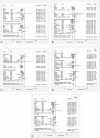Prognostic impact of chemotherapy-induced amenorrhea on premenopausal breast cancer: a meta-analysis of the literature
- PMID: 25783467
- PMCID: PMC4603367
- DOI: 10.1097/GME.0000000000000440
Prognostic impact of chemotherapy-induced amenorrhea on premenopausal breast cancer: a meta-analysis of the literature
Abstract
Objective: We conducted this meta-analysis of published data to assess the exact prognostic value of adjuvant chemotherapy-induced amenorrhea (CIA) as a prognostic factor for premenopausal breast cancer.
Methods: We searched for all relevant studies published before May 2014 in the PubMed, OVID, and EMBASE databases. Relative risks (RRs) were used to estimate the association between CIA and various survival outcomes, including disease-free survival (DFS) and overall survival (OS).
Results: This meta-analysis identified 13 eligible studies including 5,513 cases and 2,008 controls for DFS and 5 eligible studies including 2,331 cases and 776 controls for OS. Results demonstrated that CIA is associated with improved DFS (RR, 0.67; 95% CI, 0.61-0.74; P < 0.001) and OS (RR, 0.60; 95% CI, 0.50-0.72; P < 0.001). In subgroup analyses, CIA was found to affect DFS (RR, 0.73; 95% CI, 0.61-0.88; P = 0.001) in estrogen receptor (ER)-positive patients; however, similar results were not observed in ER-negative patients (for DFS: RR, 0.97; 95% CI, 0.66-1.41; P = 0.858). Participants with CIA achieved a significantly better prognosis than participants without CIA, irrespective of nodal status, chemotherapy regimen, endocrine therapy, or publication year.
Conclusions: This meta-analysis clarifies that CIA contributes to improved prognosis in premenopausal women with ER-positive breast cancer and is at least partially responsible for the benefits of adjuvant chemotherapy in these women, which induce chemical castration.
Figures



Similar articles
-
[Observation and clinical significance of adjuvant chemotherapy-induced amenorrhea in premenopausal breast cancer patients].Zhonghua Zhong Liu Za Zhi. 2006 Nov;28(11):848-51. Zhonghua Zhong Liu Za Zhi. 2006. PMID: 17416008 Chinese.
-
Prognostic Value of Chemotherapy-Induced Amenorrhea in Breast Cancer: a Meta-Analysis.Asian Pac J Cancer Prev. 2015;16(14):5939-44. doi: 10.7314/apjcp.2015.16.14.5939. Asian Pac J Cancer Prev. 2015. PMID: 26320476
-
NSAS-BC02 substudy of chemotherapy-induced amenorrhea (CIA) in premenopausal patients who received either taxane alone or doxorubicin(A) cyclophosphamide(C) followed by taxane as postoperative chemotherapy.Breast Cancer Res Treat. 2020 Jul;182(2):325-332. doi: 10.1007/s10549-020-05692-5. Epub 2020 May 28. Breast Cancer Res Treat. 2020. PMID: 32462261 Clinical Trial.
-
Amenorrhea in premenopausal women after adjuvant chemotherapy for breast cancer.J Clin Oncol. 2006 Dec 20;24(36):5769-79. doi: 10.1200/JCO.2006.07.2793. Epub 2006 Nov 27. J Clin Oncol. 2006. PMID: 17130515 Review.
-
Chemotherapy-Induced Amenorrhea and Its Prognostic Significance in Premenopausal Women With Breast Cancer: An Updated Meta-Analysis.Front Oncol. 2022 Apr 5;12:859974. doi: 10.3389/fonc.2022.859974. eCollection 2022. Front Oncol. 2022. PMID: 35463307 Free PMC article.
Cited by
-
Quantitative background parenchymal enhancement to predict recurrence after neoadjuvant chemotherapy for breast cancer.Sci Rep. 2019 Dec 16;9(1):19185. doi: 10.1038/s41598-019-55820-5. Sci Rep. 2019. PMID: 31844135 Free PMC article.
-
Association of Estrogen-Related Polygenetic Risk Scores with Breast Cancer and Interactions with Alcohol Intake, Early Menarche, and Nulligravida.Asian Pac J Cancer Prev. 2022 Jan 1;23(1):13-24. doi: 10.31557/APJCP.2022.23.1.13. Asian Pac J Cancer Prev. 2022. PMID: 35092367 Free PMC article.
-
Fertility preservation in breast cancer with case-based examples for guidance.J Assist Reprod Genet. 2020 Mar;37(3):717-729. doi: 10.1007/s10815-019-01665-w. Epub 2020 Feb 1. J Assist Reprod Genet. 2020. PMID: 32008180 Free PMC article. Review.
-
Young Women with Breast Cancer: The Current Role of Precision Oncology.J Pers Med. 2023 Nov 20;13(11):1620. doi: 10.3390/jpm13111620. J Pers Med. 2023. PMID: 38003935 Free PMC article. Review.
-
Risk of chemotherapy-related amenorrhoea (CRA) in premenopausal women undergoing chemotherapy for early stage breast cancer.Breast Cancer Res Treat. 2021 Feb;186(1):237-245. doi: 10.1007/s10549-020-05951-5. Epub 2020 Oct 12. Breast Cancer Res Treat. 2021. PMID: 33047206 Free PMC article.
References
-
- Eifel P, Axelson JA, Costa J, et al. National Institutes of Health Consensus Development Conference statement: adjuvant therapy for breast cancer, November 1-3, 2000. J Natl Cancer Inst 2001; 93:979–989. - PubMed
-
- Early Breast Cancer Trialists’ Collaborative Group. Effects of chemotherapy and hormonal therapy for early breast cancer on recurrence and 15-year survival: an overview of the randomised trials. Lancet 2005; 365:1687–1717. - PubMed
-
- Early Breast Cancer Trialists’ Collaborative Group. Ovarian ablation in early breast cancer: overview of the randomised trials. Early Breast Cancer Trialists’ Collaborative Group. Lancet 1996; 348:1189–1196. - PubMed
-
- Brincker H, Rose C, Rank F, et al. Evidence of a castration-mediated effect of adjuvant cytotoxic chemotherapy in premenopausal breast cancer. J Clin Oncol 1987; 5:1771–1778. - PubMed
-
- Bonadonna G, Valagussa P. Treating early breast cancer. Lancet 1992; 339:675. - PubMed
Publication types
MeSH terms
LinkOut - more resources
Full Text Sources
Medical

